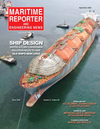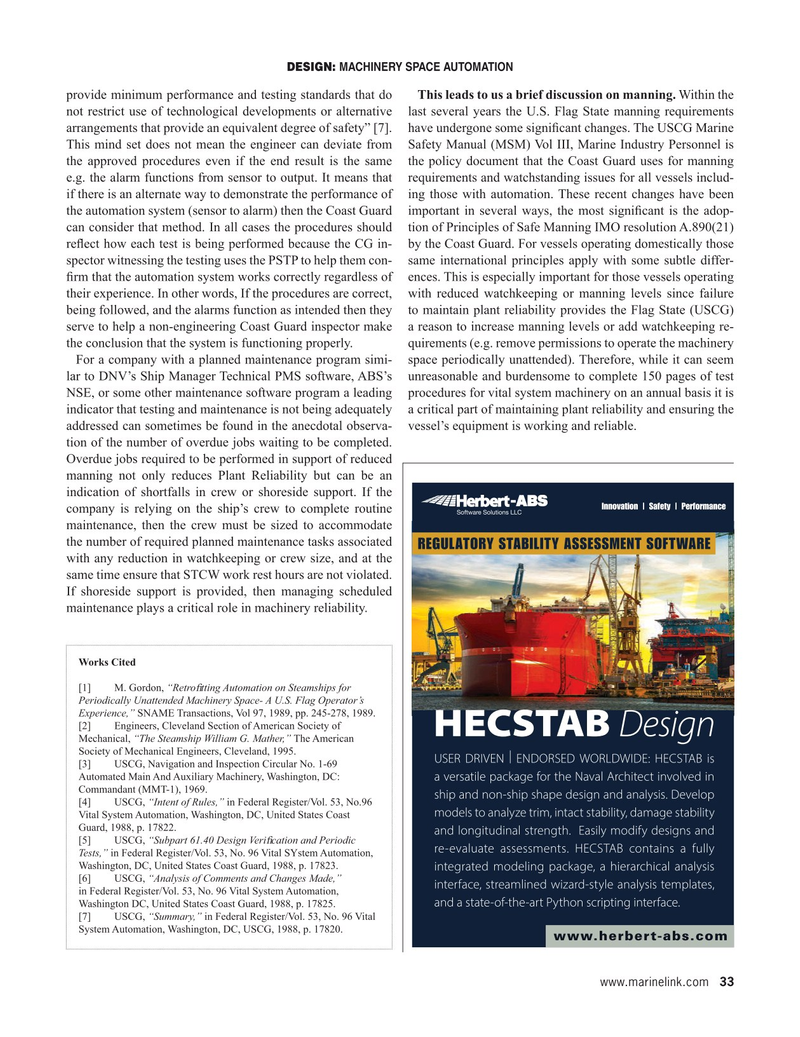
Page 33: of Maritime Reporter Magazine (September 2020)
Marine Design Annual
Read this page in Pdf, Flash or Html5 edition of September 2020 Maritime Reporter Magazine
DESIGN: MACHINERY SPACE AUTOMATION provide minimum performance and testing standards that do This leads to us a brief discussion on manning. Within the not restrict use of technological developments or alternative last several years the U.S. Flag State manning requirements arrangements that provide an equivalent degree of safety” [7]. have undergone some signi? cant changes. The USCG Marine
This mind set does not mean the engineer can deviate from Safety Manual (MSM) Vol III, Marine Industry Personnel is the approved procedures even if the end result is the same the policy document that the Coast Guard uses for manning e.g. the alarm functions from sensor to output. It means that requirements and watchstanding issues for all vessels includ- if there is an alternate way to demonstrate the performance of ing those with automation. These recent changes have been the automation system (sensor to alarm) then the Coast Guard important in several ways, the most signi? cant is the adop- can consider that method. In all cases the procedures should tion of Principles of Safe Manning IMO resolution A.890(21) re? ect how each test is being performed because the CG in- by the Coast Guard. For vessels operating domestically those spector witnessing the testing uses the PSTP to help them con- same international principles apply with some subtle differ- ? rm that the automation system works correctly regardless of ences. This is especially important for those vessels operating their experience. In other words, If the procedures are correct, with reduced watchkeeping or manning levels since failure being followed, and the alarms function as intended then they to maintain plant reliability provides the Flag State (USCG) serve to help a non-engineering Coast Guard inspector make a reason to increase manning levels or add watchkeeping re- the conclusion that the system is functioning properly. quirements (e.g. remove permissions to operate the machinery
For a company with a planned maintenance program simi- space periodically unattended). Therefore, while it can seem lar to DNV’s Ship Manager Technical PMS software, ABS’s unreasonable and burdensome to complete 150 pages of test
NSE, or some other maintenance software program a leading procedures for vital system machinery on an annual basis it is indicator that testing and maintenance is not being adequately a critical part of maintaining plant reliability and ensuring the addressed can sometimes be found in the anecdotal observa- vessel’s equipment is working and reliable.
tion of the number of overdue jobs waiting to be completed.
Overdue jobs required to be performed in support of reduced manning not only reduces Plant Reliability but can be an indication of shortfalls in crew or shoreside support. If the
Innovation | Safety | Performance company is relying on the ship’s crew to complete routine maintenance, then the crew must be sized to accommodate the number of required planned maintenance tasks associated
REGULATORY STABILITY ASSESSMENT SOFTWARE with any reduction in watchkeeping or crew size, and at the same time ensure that STCW work rest hours are not violated.
If shoreside support is provided, then managing scheduled maintenance plays a critical role in machinery reliability.
Works Cited [1] M. Gordon, “Retro? tting Automation on Steamships for
Periodically Unattended Machinery Space- A U.S. Flag Operator’s
Experience,” SNAME Transactions, Vol 97, 1989, pp. 245-278, 1989. [2] Engineers, Cleveland Section of American Society of
HECSTAB Design
Mechanical, “The Steamship William G. Mather,” The American
Society of Mechanical Engineers, Cleveland, 1995.
USER DRIVEN | ENDORSED WORLDWIDE: HECSTAB is [3] USCG, Navigation and Inspection Circular No. 1-69
Automated Main And Auxiliary Machinery, Washington, DC: a versatile package for the Naval Architect involved in
Commandant (MMT-1), 1969. ship and non-ship shape design and analysis. Develop [4] USCG, “Intent of Rules,” in Federal Register/Vol. 53, No.96 models to analyze trim, intact stability, damage stability
Vital System Automation, Washington, DC, United States Coast
Guard, 1988, p. 17822.
and longitudinal strength. Easily modify designs and [5] USCG, “Subpart 61.40 Design Veri? cation and Periodic re-evaluate assessments. HECSTAB contains a fully
Tests,” in Federal Register/Vol. 53, No. 96 Vital SYstem Automation,
Washington, DC, United States Coast Guard, 1988, p. 17823.
integrated modeling package, a hierarchical analysis [6] USCG, “Analysis of Comments and Changes Made,” interface, streamlined wizard-style analysis templates, in Federal Register/Vol. 53, No. 96 Vital System Automation, and a state-of-the-art Python scripting interface.
Washington DC, United States Coast Guard, 1988, p. 17825.
[7] USCG, “Summary,” in Federal Register/Vol. 53, No. 96 Vital
System Automation, Washington, DC, USCG, 1988, p. 17820.
www.herbert-abs.com www.marinelink.com 33
MR #9 (18-33).indd 33 9/9/2020 10:27:09 AM

 32
32

 34
34
